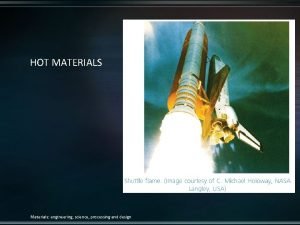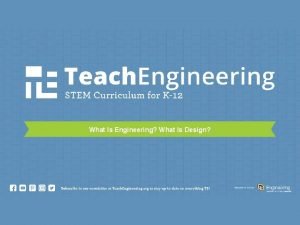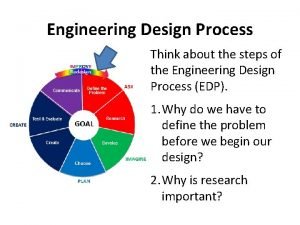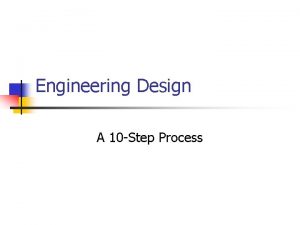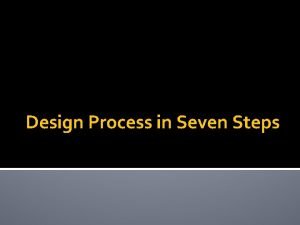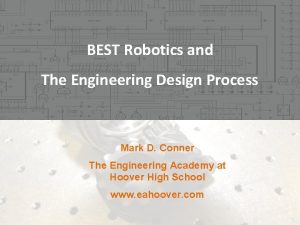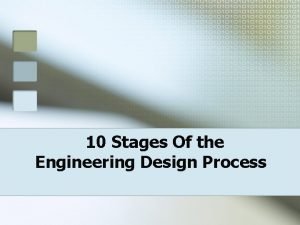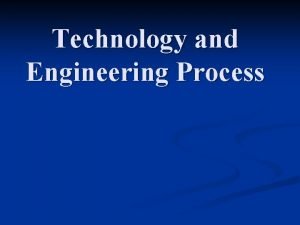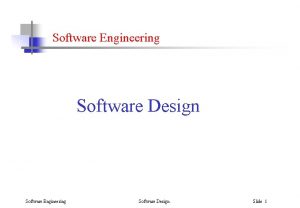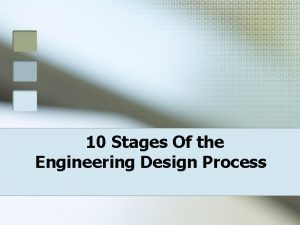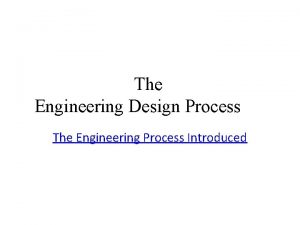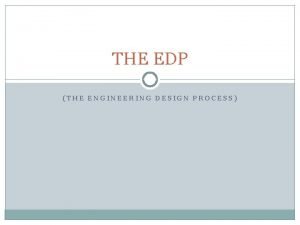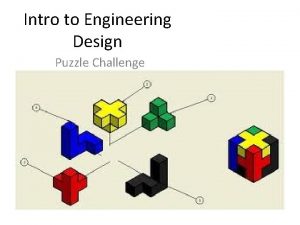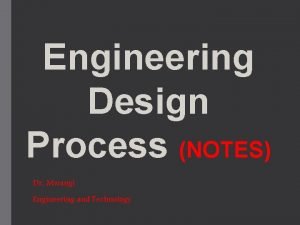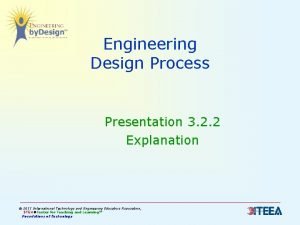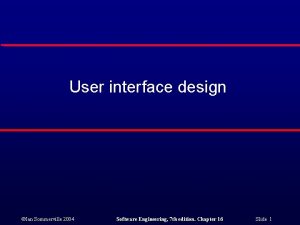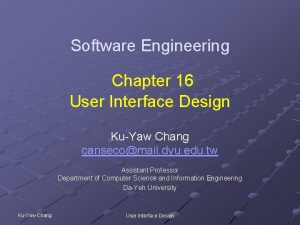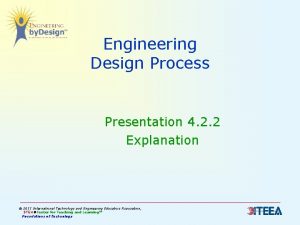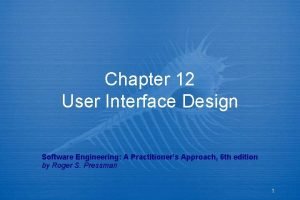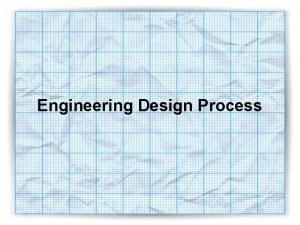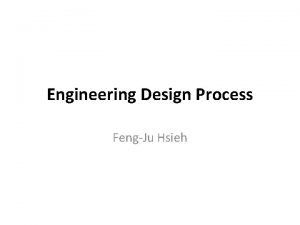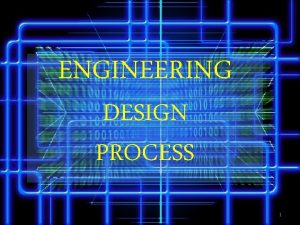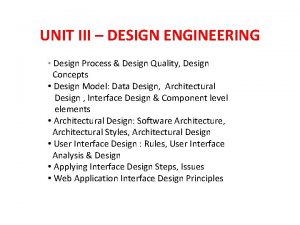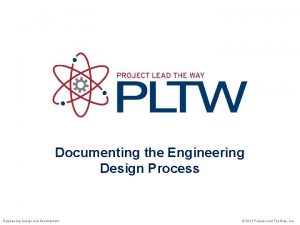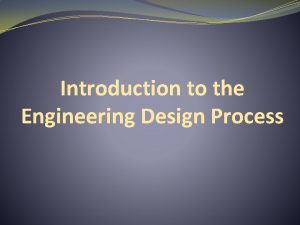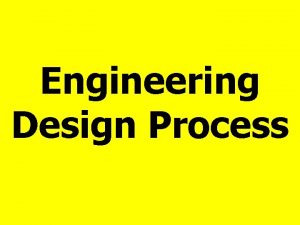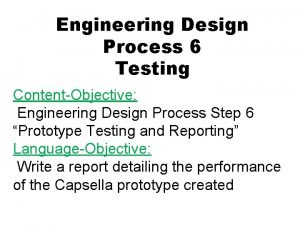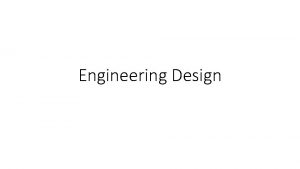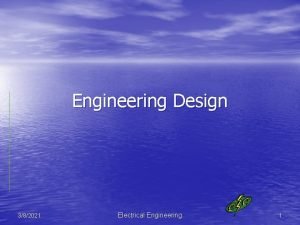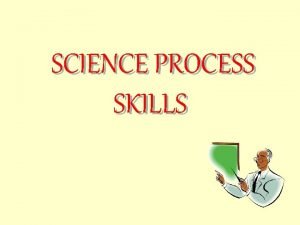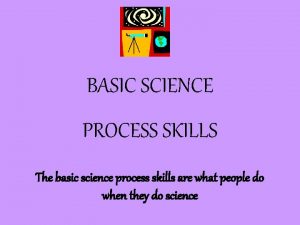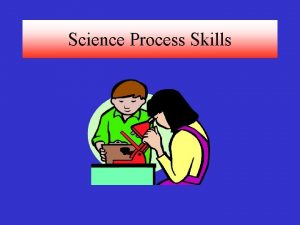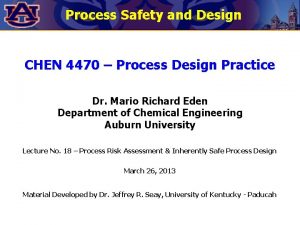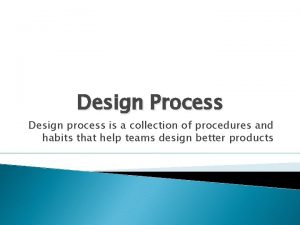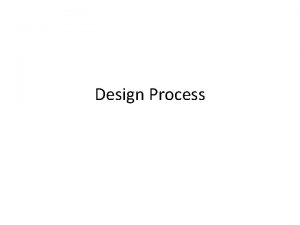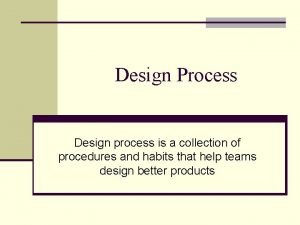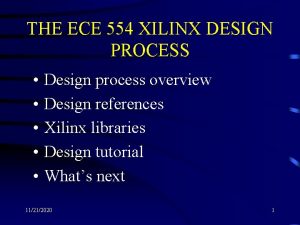L 1 The engineering design process Engineering science















![Elements of the design process • [1] Problem identification – What is the problem Elements of the design process • [1] Problem identification – What is the problem](https://slidetodoc.com/presentation_image_h/113263a6fec0576d3d88e79d8f3d9541/image-16.jpg)
![• [4] Concept generation – The design is open-ended, so you must generate • [4] Concept generation – The design is open-ended, so you must generate](https://slidetodoc.com/presentation_image_h/113263a6fec0576d3d88e79d8f3d9541/image-17.jpg)
![• [7] System integration – All the subsystems are brought together to produce • [7] System integration – All the subsystems are brought together to produce](https://slidetodoc.com/presentation_image_h/113263a6fec0576d3d88e79d8f3d9541/image-18.jpg)









- Slides: 27

L 1: The engineering design process • • Engineering science vs. design What is an engineer? Engineering design Elements of the design process

Engineering science vs. design • Engineering science problems – Problem statement is compact and well-posed – Problem uses specialized knowledge – Problem has a readily identifiable closure – Solution is unique and compact 1

• Engineering science problems – – Problem statement is compact and well-posed Problem uses specialized knowledge Problem has a readily identifiable closure Solution is unique and compact How much current is flowing through the circuit 0. 1 sec after the switch is closed? 2

• Engineering design problems – – 3 Problem statement is incomplete, ambiguous, and self-contradictory Problem requires integration of knowledge from many fields Problem does not have a readily identifiable closure Solutions are neither unique nor compact

• Engineering design problems – – Problem statement is incomplete, ambiguous, and self-contradictory Problem requires integration of knowledge from many fields Problem does not have a readily identifiable closure Solutions are neither unique nor compact Design a system for lifting and moving loads of up to 5000 lb in a manufacturing facility. The facility has an unobstructed span of 50 ft. The lifting system should be inexpensive and satisfy all relevant safety standards. 4

What is an engineer? • En-gi-neer (n) One who employs the innovative and methodical application of scientific knowledge and technology to produce a device, system or process, which is intended to satisfy human needs –American College Dictionary 5

What is an engineer? En-gi-neer (n) One who employs the innovative and methodical application of scientific knowledge and technology to produce a device, system or process, which is intended to satisfy human needs –American College Dictionary – Methodical application of scientific knowledge and technology • In contrast with other design/creative endeavors, e. g. , creative writing – Innovative vs. methodical • Both terms are in competition • A good engineer is aware of this and uses both effectively – Satisfy human needs • You must determine the user’s needs and apply technology ethically 6

What is engineering design? Engineering design is the process of devising a system, component, or process to meet desired needs. It is a decision-making process (often iterative), in which the basic sciences, mathematics, and engineering sciences are applied to convert resources optimally to meet a stated objective. Among the fundamental elements of the design process are the establishment of objectives and criteria, synthesis, analysis, construction, testing, and evaluation. [ABET] 7

Engineering design is the process of devising a system, component, or process to meet desired needs. It is a decision-making process (often iterative), in which the basic sciences, mathematics, and engineering sciences are applied to convert resources optimally to meet a stated objective. Among the fundamental elements of the design process are the establishment of objectives and criteria, synthesis, analysis, construction, testing, and evaluation. [ABET] – The design process • Problem-solving methodologies that aim to develop a system that best meets the customer’s needs within given constraints – Iterative • In recognition that early in the process you don’t know all the answers (or sometimes even the questions) – Meeting an objective • There is always one (or multiple) –engineering design is not aimless 8

Types of design processes • Prescriptive – They set down an exact process or recipe for realizing a system – Often algorithmic and expressed on flow charts with decision logic • Descriptive – Describe typical activities involved in realizing designs – Less formal, less emphasis on exact sequencing 9

• Why follow a design process? – It formalizes thought processes to ensure good practices are followed, which leads to better and more innovative solutions – It keeps all members of the team synchronized in terms of understanding where they are in the process 10

A prescriptive design process 11

– This model is unrealistic, and ignores the iterative nature of design, where the team alternates between different phases as needed 12

A descriptive design process 13

A descriptive design process – Allows transitions between the different phases – The engineer may alternate between nearby phases • e. g. , between problem ID, research, requirements specs, concept generation – However, transitions between remote phases can be costly • e. g. , the customer needs may change, which requires reevaluation of needs, requirements specifications 14
![Elements of the design process 1 Problem identification What is the problem Elements of the design process • [1] Problem identification – What is the problem](https://slidetodoc.com/presentation_image_h/113263a6fec0576d3d88e79d8f3d9541/image-16.jpg)
Elements of the design process • [1] Problem identification – What is the problem being solved or the customer need to be met? – Could result from someone conceiving a new idea or from a client approaching you with a need • [2] Research – Immersion in basic engineering, scientific principles and technologies – You must become a domain expert to avoid reinventing the wheel • [3] Requirements specification – Articulates what the system must do for it to be successful and be accepted by the customer – Very challenging for engineers since we are trained to solve problems instead of specifying them 15
![4 Concept generation The design is openended so you must generate • [4] Concept generation – The design is open-ended, so you must generate](https://slidetodoc.com/presentation_image_h/113263a6fec0576d3d88e79d8f3d9541/image-17.jpg)
• [4] Concept generation – The design is open-ended, so you must generate multiple solutions – Alternates creative thought and critical evaluation (not simultaneously) • [5] Design – Iteratively develop a technical solution, leading to a detailed design – Upon completion, all major systems and subsystems are identified and described using an appropriate model (e. g. , functional, behavior) • [6] Prototyping/construction – Different elements of the system are constructed and tested – In prototyping, the goal is to experiment, establish proof-of-concept, and improve understanding 16
![7 System integration All the subsystems are brought together to produce • [7] System integration – All the subsystems are brought together to produce](https://slidetodoc.com/presentation_image_h/113263a6fec0576d3d88e79d8f3d9541/image-18.jpg)
• [7] System integration – All the subsystems are brought together to produce a working system – Requires clear communication of functionality and interfaces during the design phase • [8] Testing – Unit tests, regression test, integration test, acceptance test – The final objective is to demonstrate that the overall system meets the client’s needs • [9] Maintenance – After deployment: maintain, upgrade, add new functionality, correct design problems 17

Technology-specific design processes 18

VLSI design Embedded system design 19 Software development (waterfall)

Topography of engineering science and design Courtesy of Dr. Gutierrez-Osuna Solid ground of engineering science Design swamp 20

Typical engineering student with science and mathematics background Solid ground of engineering science Design swamp 21

Design professor This way Solid ground of engineering science Design swamp 22

Design skills Solid ground of engineering science Design swamp 23

Course objectives Design process Design tools Design skills Professional skills 24

Design process • Needs specification • Requirements specification • Concept generation Design tools Design skills Professional skills 25 • Functional decomposition • Behavior models • Testing • • Teamwork Project management Ethical/legal issues Oral presentations

Lecture summary § § 26 Engineering design is an iterative process Design problems are open-ended with many potential solutions Design processes represent best practices for realizing a system Design processes may be prescriptive or descriptive
 My favourite subject is
My favourite subject is Materials engineering science processing and design
Materials engineering science processing and design Engineering design process quiz
Engineering design process quiz Basic engineering design process
Basic engineering design process What are the steps for the engineering design process
What are the steps for the engineering design process 10 steps of engineering design process
10 steps of engineering design process 7 steps of design process
7 steps of design process Engineering design process
Engineering design process Stages of engineering
Stages of engineering Imagine that you are an engineer
Imagine that you are an engineer Software engineering slides
Software engineering slides The 10 steps of the engineering design process
The 10 steps of the engineering design process Engineering design process
Engineering design process Edp design process
Edp design process Engineering cube puzzle
Engineering cube puzzle Engineering design process notes
Engineering design process notes Scientific method vs engineering design process
Scientific method vs engineering design process User interface design process in software engineering
User interface design process in software engineering Interface analysis in software engineering
Interface analysis in software engineering Scientific method vs engineering design process
Scientific method vs engineering design process Interface analysis means understanding
Interface analysis means understanding Split range
Split range Hình ảnh bộ gõ cơ thể búng tay
Hình ảnh bộ gõ cơ thể búng tay Ng-html
Ng-html Bổ thể
Bổ thể Tỉ lệ cơ thể trẻ em
Tỉ lệ cơ thể trẻ em Voi kéo gỗ như thế nào
Voi kéo gỗ như thế nào Tư thế worm breton
Tư thế worm breton

